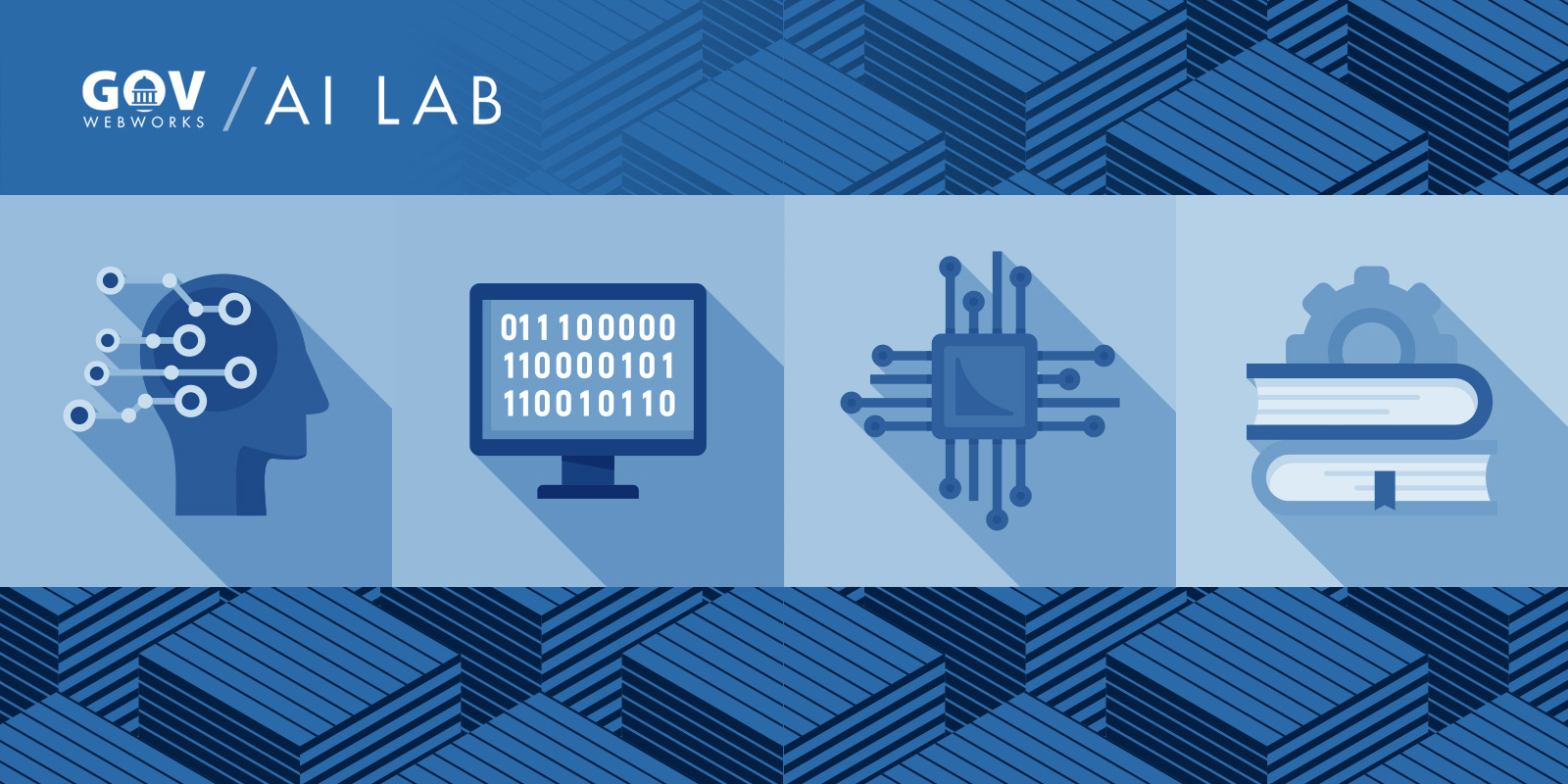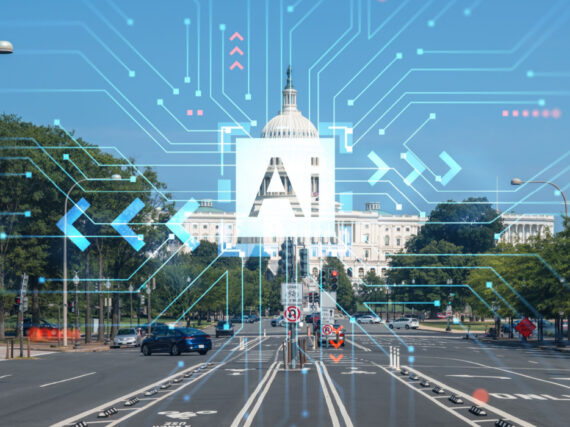Welcome to the February AI Newsletter from the GovWebworks AI Lab. The following articles touch on important topics in the industry, including:
- Building public trust in AI
- NLP and text mining to manage data and content
- Media labeling with AI
- Growth in the smart speaker market
- Private sector examples for how AI can increase efficiency
- AI initiatives to help the environment
- How the AI Incident Database can help with ethical issues
- Making user experience more personal with conversational apps
We hope you find this information as interesting as we do. If so, feel free to share with your colleagues and encourage them to sign up for the AI Newsletter and join the conversation! Or email us at ailabs@govwebworks.com to talk about using AI to optimize your organization’s digital goals.
#1: Why it’s important to market your AI initiatives
Key takeaway: Build trust in AI with planning, communication, and transparency
Reviewed by Adam Kempler
A particular sentence in this article caught my attention: “If you don’t have public trust in AI, you won’t be able to advance it.” This is an important point for government agencies introducing AI into their products and services. Whether it’s a highly visible public chatbot or behind the scenes/under the hood AI integrations such as forecasting, recommendation engines, automated tagging, and other other AI augmented capabilities. It is import to create awareness, set expectations, and provide transparency both internally and externally around these implementations.
There is often fear and uncertainty among audiences as to bias and other issues related to AI. Adding information about your AI initiatives on your website, intranet, and via other channels gives you the opportunity to highlight the positive impact these tools can have for audiences. Even for internal projects it’s important to communicate how AI is being used and manage expectations from the beginning. Things to identify are the benefits the initiative will bring, potential roadmaps, plans for how the initiative will be monitored and improved in an ongoing basis, and any mechanisms for feedback, if applicable.
The US Needs More Foreign Artificial Intelligence Know-How
#2: Make content and assets easier to find with conversational interfaces
Key takeaway: Natural Language Processing (NLP) and text mining can provide tremendous value when applied to large amounts of content, data, and files
Reviewed by Adam Kempler
Leveraging the capabilities of conversational interfaces (via NLP) allows for more intuitive and expressive searching of large quantities of documents. Opening up this type of search to audiences on the many thousands of PDFs and other documents government websites contain can help provide better engagement and reduce support requests by more accurately connecting users with the information they’re seeking.
Additionally, using NLP on government assets can help provide better cross-referencing of related documents. For example NLP can identify “entities” in documents, such as people, places, and things, even if they are named differently across documents. For example, if someone was reading a legislative impact statement about a new law that applies in Cherokee county, NLP will identify Cherokee as a “Place” entity.
NLP can then identify other documents with the same entity. It also identifies the entities based on context, so it can tell the difference between Cherokee the county versus a designation like the Cherokee Nation. Why is that important? So that you can provide links allowing users to get additional relevant information based on the documents they are looking at, easily building a “Related Documents” sidebar. If someone was looking at a document about Apple computers, you wouldn’t want to show them documents that were about apple trees just because they also mention “apple”. This is where NLP (and Natural Language Understanding) can really shine.
Reducing Time-to-Hire and Finding Niche Candidates via Text Mining and NLP
#3: Using AI to create more findable and accessible content
Key takeaway: AI/Machine Learning as Service can assist content creators in the labeling of media such as photos, video, and even audio
Reviewed by Adam Kempler
Labeling media with AI can provide the following benefits to government staff in charge of creating and managing content:
- Time savings: It can be very time consuming to determine good descriptions to use as alt tags and descriptive text for media such as images and video. Having an AI assistant provide a list of recommended tags and auto-generated descriptions can save a lot of time, allowing staff to focus on more critical tasks. Using this generated content becomes part of the content creation workflow, allowing editors to review the AI generated content, customize it if/as desired, and then have it automatically applied to the media.
- Increases the findability of content and improve SEO: For example, at the Missouri Department of Conservation, staff might upload a picture of a deer. Typical tags might be “deer” and “white tailed deer”. However, the AI content assistant, using Machine Vision, will list additional tags including “antlers”, “mammal”, “brown”, and “fur” that the user can just check off. Why is this important? Because now we can create much richer search experiences. For example users could search for images of all mammals with antlers. Or search for examples of all mammals with brown fur. This type of extended metadata is applicable to all types of media and assets.
- Increases accessibility: Providing good alt text and captions for media is critical for good site accessibility. It can also be time consuming to do well. Using AI tools can dramatically improve accessibility while reducing the time needed to do it effectively.
We recommend that any integration of these services incorporate an HiTL (Human-in-the-loop). The AI serves as an assistant, and the recommendations are reviewed and selected by the staff member responsible for the content.
What’s that? Microsoft’s latest breakthrough, now in Azure AI, describes images as well as people do
#4: The smart speaker market is expected to grow 21% this year
Key takeaway: Be where your audience is, from mobile first to voice first
Reviewed by Ravi Jackson
Most companies and government agencies have adopted a mobile-first approach in line with user expectations and pervasive growth in smartphone usage. However, many are unprepared for the next wave of disruption. The growth in the smart speaker market points to a growing trend among consumers who want to interact with services and information with less friction. Two things are occurring:
- Early adopters of this technology are upgrading to better devices
- More households are choosing to adopt voice enabled devices as a primary means to connect with companies online
The implication for the public sector is that they will will need to follow suit. There will soon be an expectation that in addition to a good website, agencies will need to incorporate the ability for people to connect with information and services via a smart speaker from their home or car. For example, citizens may be asking questions like, “What are the most in-demand jobs in my area?”, or “How do I apply for SNAP benefits?”, or “How do I renew my license?”. While a lot of these routine questions can be easily searched online now, users are seeking the more immediate answers to these types of questions with less friction. This will mean creating other avenues for users to engage, hence the growth in the smart speaker market. Corporations are getting wise to this trend and quickly adapting. The public sector should start planning for this change as well.
Smart speakers are becoming more popular: Why this should matter to you.
#5: Five things your company should know before investing in Artificial Intelligence
Key takeaway: AI is here to stay. The good news is the private sector has done the R&D for you, just follow their lead
Reviewed by Ravi Jackson
The private sector has been exploring use cases for AI for several years. This has resulted in more companies adopting AI into their operations during the pandemic lockdowns as a way to boost efficiency and profits. “According to the study The Enterprise Powered by AI, by the consulting firm Capgemini, 97% of the companies surveyed said they have seen measurable benefits from the implementation of AI. For this reason, and as a result of the pandemic, 78% of business leaders affirmed that they will continue to invest in AI in the way they did before COVID-19, and one in five said they even plan to increase their investment.”
Ok, so this is interesting, but why does it matter for the public sector? Because the private sector has spent the last few years investing in R&D to find the best tools and use cases for AI. Government agencies can now reap the rewards by adopting the best solutions without upfront costs and disruption. By observing the types of AI tools private companies are actually deploying, the public sector can see what works, and then decide how some of these may translate for government use cases. One obvious example are customer support chatbots which allow routine questions to be answered automatically without excessive human interaction, thus freeing up valuable staff time.
The trick is knowing where and how to start. In a nutshell:
- Find programs or areas which could benefit from a technology boost
- Find the correct tool to meet the need
- Prepare staff for operational adjustments
- Bring in some outside help – (technology vendors who know what tools to use, how to use them, and how to help you be successful)
- Launch small, and keep building
AI is here to stay. The private sector has embraced these tools as essential to their survival. The public sector can learn from the successful AI stories and integrate these tools into various departments/programs to increase efficiency and improve customer service.
5 Key things to know before launching your AI project
#6: Saving the planet, with help from AI
Key takeaway: AI can provide a new way of looking at challenging problems, including environmental issues
Reviewed by Kevin Ferguson
Making progress on social concerns related to environmental health can be a win-win for the public sector, but the challenges in this space aren’t getting any easier. AI technologies are providing new tools and ways to look at these problems. The following article offers six AI initiatives that are starting to move the needle on environmental issues.
AI is providing new tools to help address complex environmental issues
#7: AI Incident Database paves the path for safer AI for humans
Key takeaway: AI incidents don’t follow the same patterns as traditional IT incidents and require new ways of looking at them, including borrowing tools from other industries that are familiar with non-binary outcomes
Reviewed by Kevin Ferguson
Until recently, organizations looking to limit their risk when rolling out AI and Machine Learning systems were mostly on their own. Aside from some very public missteps, the details surrounding incidents of bad behavior in AI were mostly isolated. Taking a page from the aviation industry, which has an established history of sharing information to help the field progress as a whole in the face of complex failures, an AI Incident Database (AIID) has been created to help disseminate the details surrounding AI flaws.
This is of particular interest to the public sector and governments that have recently been wrangling with the ethical impacts that come up when AI systems fail to operate as expected. “Fairness issues are the most common AI incidents submitted to AIID, particularly in cases where governments are using intelligent systems, like facial recognition programs.”
#8: Making conversational apps more personal
Key takeaway: Conversational apps can enhance user experience
Reviewed by Ravi Jackson
Conversational apps use AI to guide users towards specific goals or actions by simulating human conversation. These apps are increasingly found on modern websites and on mobile applications. According to Hubtype, conversational apps cut down goal completion time for users by 40% and increase the completed number of goals by 25%.
This article looks at four different examples of good conversational apps:
- Duolingo: A language-based learning platform using a blend of text, images, and positive reinforcement to help users learn
- Cleo: A money management app that helps users navigate day-to-day finances in a more playful and entertaining/engaging manner
- Marsbot: A chatbot and conversational app that provides a more personalized experience for recommending restaurants, based upon where you take your smartphone
- Quartz: Provides a conversational approach to sharing international news and business insights with users, including GIFs, photos, and comments to provide a more individual experience
These four conversational apps demonstrate that the market is moving towards a customized and more personal and interactive user experience. For the public sector, this may mean breaking away from old language, impersonal service delivery, and rigid structures. Many of the more personal and welcome elements of these apps include easy-to-implement and iterate features like the inclusion of conversational text, pictures and visual images, positive reinforcement and feedback, and data to deliver a better interaction for each individual user.
Learn more
- Sign up for the AI Newsletter for a roundup of the latest AI-related articles and news delivered to your inbox
- Find out more about using AI to optimize your organization’s digital goals







